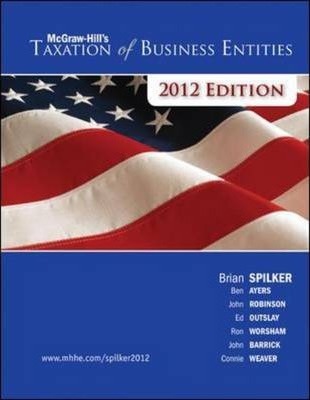
McGraw-Hill's Taxation of Business Entities 3rd Edition by Connie Weaver, Brian Spilker, Edmund Outslay, John Robinson, Ronald Worsham, Benjamin Ayers, John Barrick
Edition 3ISBN: 9780077924522
McGraw-Hill's Taxation of Business Entities 3rd Edition by Connie Weaver, Brian Spilker, Edmund Outslay, John Robinson, Ronald Worsham, Benjamin Ayers, John Barrick
Edition 3ISBN: 9780077924522 Exercise 66
{Research} Adam elects the accrual method of accounting for his business. What amount of deductions does Adam recognize in year 0 for the following transactions
a. Adam guarantees that he will refund the cost of any goods sold to a client if the goods fail within a year of delivery. In December of year 0, Adam agreed to refund $2,400 to clients, and he expects to make payment in January of year 1.
b. On December 1 of year 0, Adam paid $480 for a one-year contract with CleanUP Services to clean his store. The agreement calls for services to be provided on a weekly basis.
c. Adam was billed $240 for annual personal property taxes on his delivery van. Because this was the first time Adam was billed for these taxes, he did not make payment until January. However, he considers the amounts immaterial.
a. Adam guarantees that he will refund the cost of any goods sold to a client if the goods fail within a year of delivery. In December of year 0, Adam agreed to refund $2,400 to clients, and he expects to make payment in January of year 1.
b. On December 1 of year 0, Adam paid $480 for a one-year contract with CleanUP Services to clean his store. The agreement calls for services to be provided on a weekly basis.
c. Adam was billed $240 for annual personal property taxes on his delivery van. Because this was the first time Adam was billed for these taxes, he did not make payment until January. However, he considers the amounts immaterial.
Explanation
Accrual Basis:
Under the accrual basis ...
McGraw-Hill's Taxation of Business Entities 3rd Edition by Connie Weaver, Brian Spilker, Edmund Outslay, John Robinson, Ronald Worsham, Benjamin Ayers, John Barrick
Why don’t you like this exercise?
Other Minimum 8 character and maximum 255 character
Character 255


